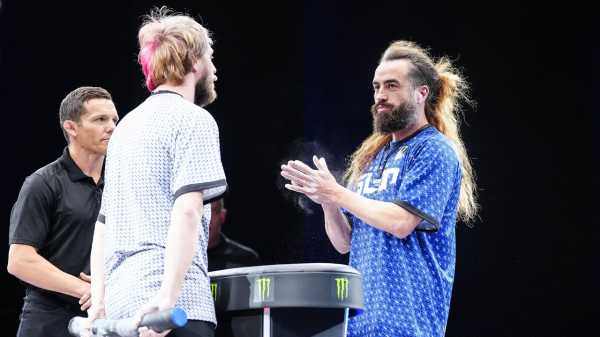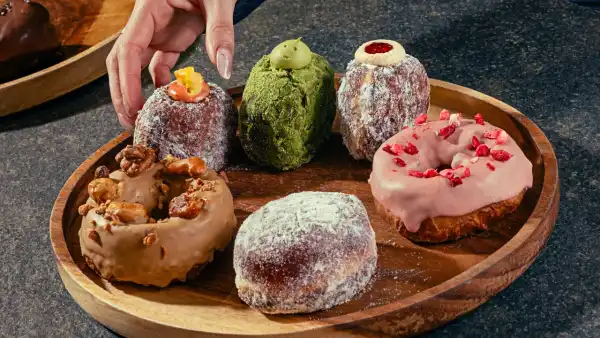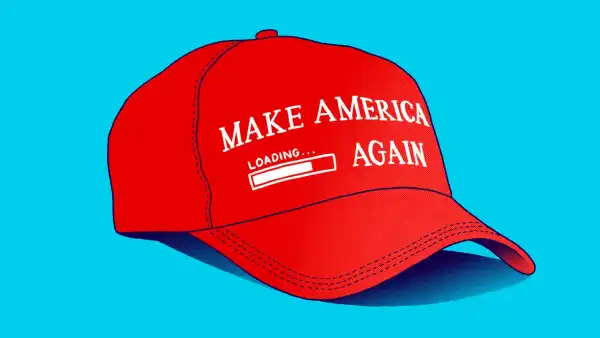
“Take some deep breaths, you’re doing fine.” That’s what the doctor was telling a man named Chris Kennedy, but Kennedy did not look as if he was doing fine. He was flat on his back, with someone cradling his head, and he was just starting to look around. After a moment, he sat up, and perhaps he registered that he was on a large padded stage, beneath lights, with a camera crew hovering.
“You got knocked out,” someone else said.
Kennedy considered this. “Got knocked out doing what?” he asked. “Was I fighting?”
The answer to that question may depend on how you define “fighting.” Moments before, Kennedy had been standing motionless in front of a podium, with both hands behind his back. On the other side of the podium stood his opponent, who wound up and smacked Kennedy in the face. Kennedy collapsed instantly and grotesquely—arms stiff, fingers gnarled. It was the American cable début of not just a show but perhaps a sport. The show is “Power Slap: Road to the Title,” which had its première earlier this month on TBS, a network that also broadcasts baseball and hockey. The sport is known as slap fighting, an activity that may well be, like the blows exchanged by its participants, impossible to defend. In slap fighting, there is no evasion, no trickery, no possibility of a swing and a miss. Just two people taking turns slapping each other in the face.
By any reasonable standard, this is an absurd idea, and quite possibly a bad one. Stefon Diggs, the Buffalo Bills wide receiver, posted clips of the show on his Instagram page, writing, “I NEVER WATCH TV ANYMORE ONLY NETFLIX AND THIS WHAT BE ON TV JESUS CHRIST.” Chris Nowinski, a former professional wrestler who is now a neuroscientist working to prevent brain trauma in sports, didn’t find it at all funny, and he expressed his outrage on Twitter. “Pure exploitation,” he wrote. “What’s next, ‘Who can survive a stabbing’?”
The show is hosted by Dana White, the president of the U.F.C., the preëminent organization in mixed martial arts. This new program is patterned after “The Ultimate Fighter,” an ongoing reality show that was launched in 2005 and that helped change the public perception of M.M.A.: the sport, sometimes known as cage fighting, was famously dismissed by Senator John McCain as “human cockfighting” but is now a regular part of the ESPN lineup, and the U.F.C. is a major subsidiary of Endeavor, the sports and entertainment conglomerate. In “Power Slap,” as on “The Ultimate Fighter,” the contestants live in a house and compete for the chance to become professional slappers. “The beautiful thing about this thing is you get to slap the shit out of all the fuckin’ people you don’t like,” White apparently says to the contestants. (“Apparently,” because on TBS the slaps are uncensored but the language is not.) He promises them that the show will be “a life-changing experience in a lot of different ways,” and he seems to mean it as a guarantee rather than a dark prophecy.
Slap fighting is outrageous by design. But, in the case of “Power Slap,” some of the outrage has come from a surprising quarter: the world of professional fighting. In the nineties, boxers were aghast at the sight of an M.M.A. fighter knocking his opponent down and then jumping on top of him, raining punches until the referee shoved him off. Now many M.M.A. fans are appalled by the spectacle of two people just standing and swinging. Bloody Elbow, an M.M.A. publication, called slap fighting “gross” and an “alleged sport”; Ariel Helwani, a leading M.M.A. journalist, said, “That’s not sport—shame on Nevada, for sanctioning that.” (“Power Slap,” like the U.F.C., is based in Las Vegas.) Ryan Garcia, one of the most popular boxers in America, put it simply: “Power slap is a horrible idea and needs to be stopped.”
Much of the backlash has been directed at White, long a polarizing figure in M.M.A. White made headlines earlier this month after he was involved in an incident of intimate-partner violence. Cameras in a Mexican night club captured him seeming to argue with his wife. She slapped him. He slapped her back. White apologized but said that his only “punishment” would be damage to his reputation. “Power Slap” briefly disappeared from the TBS schedule, and then made its début on Wednesday, January 18th, a week late, and quietly—there is scarcely any sign of the show on TBS’s social-media pages.
Until recently, “Power Slap” seemed sure to push the sport into the mainstream. Now it’s not so clear. JT Tilley runs SlapFIGHT Championship, the most successful American slap-fighting league, and he serves as a consultant to the TBS show. “We don’t know what’s going to happen as a result of ‘Power Slap,’ ” he told me. He has been promoting slap fights since 2017, and he is aware that not everyone loves it. “Ninety per cent of the people can’t stand this sport—they think it’s unfair,” he said. “But ten per cent become emphatic about it.”
People have been slapping one another since before we were people: just about any creature with a hand, or a paw, will sometimes be moved to swing it in irritation, often without first making a fist. So no one can claim to have invented slapping, or even competitive slapping. In the mid-aughts, the New York hip-hop radio station Hot 97 hosted a series of “Smackfest” competitions, in which listeners traded slaps in hopes of winning money; the New York Post reported, in 2005, that the spectacle had been halted by the state’s athletic commission, which deemed it an “illegal boxing” contest. (Headline: “HOT 97’S VICIOUS ‘SMACKFEST’ KO’D; N.Y. BANS GAL-SLAP EVENT.”) But slap fights continued, often at strip clubs or night clubs—for a time, an event called Bitch Slap Thursdays entertained revellers in Memphis. In 2015, a slapping contest from a tattoo convention went viral on YouTube (the video now has more than seventy-three million views), and, in 2018, the Internet delighted over a slapping contest in Russia; the next year, the sport produced its first breakout star, Vasily Kamotsky, known as Pelmen, or Dumpling, reflecting his diet.
A slap is louder than a punch, possibly less injurious, and often more insulting. When Will Smith slapped Chris Rock, at last year’s Academy Awards, Rock seemed largely uninjured, but stunned. (In the aftermath, Tilley told TMZ that he would be happy to host a rematch.) As one “Power Slap” contestant put it, “There’s nothing more humiliating than a nice open-hand slap.” In boxing, slapping is illegal, but, in M.M.A., it is merely unwise, although not always: the brothers Nick and Nate Diaz are known for taunting their opponents, mid-fight, with a “Stockton slap,” named for their California home town. In some of the earlier slapping contests, especially the ones between women, the slappers were objects of amusement; onlookers would chuckle, as if to say, “Look at ’em go!” But by the time Kamotsky, with his enormous, doughy belly, captivated the world, slappers were more intimidating. Slapping contests appeared to reliably generate one thing that fight fans tend to want, even if deep down they know they shouldn’t: knockouts.
There is no safe way to slap someone unconscious. In 2021, in Poland, a strongman and former M.M.A. fighter named Artur (Waluś) Walczak was slapped to death at an event in Wrocław. Violent sports typically rely on rules designed to temper the underlying violence, or perhaps to camouflage it. The Marquess of Queensberry Rules, from 1967, granted fighters a one-minute break after every three minutes of combat; the length of fights was subsequently capped at fifteen rounds and then, in the nineteen-eighties, after a fighter named Kim Duk-koo endured a fatal beating on network television, capped at twelve. The U.F.C. took M.M.A. mainstream not just with clever marketing but by eliminating some of the most grisly tactics, including the practice of aiming a “soccer kick” at the head of an opponent who has been knocked down. Even football, these days, has not just pads and helmets but increasingly complicated prohibitions: fans can now spend pleasant afternoons arguing over referees’ interpretations of what exactly it means to “rough” a passer, or which receivers should be considered “defenseless” and therefore deserving of special protection.
Tilley wants people to understand that slap fighting isn’t as anarchic as it might first seem. He is a garrulous former comedian and a veteran of combat sports who owns a gym in Branson, Missouri; he saw slap-fighting videos going viral and decided to put together his own organization. He operated under the radar, often organizing fights in undisclosed locations, without an audience, in hopes of generating enough video content to sell to sports networks or to build up his YouTube channel, which now has more than two hundred thousand subscribers. He said that he’d also hired medical personnel and emergency medical technicians, separated slappers by weight, and eventually decided to limit the number of rounds in a contest.
In Tilley’s view, there are three paramount rules: “no stepping, no clubbing, no flinching.” The first is simple: the slapper must keep both feet square and planted, so as not to generate extra torque. The last is obvious: the opponent can’t try to evade the slap. But the middle rule is probably the most important: a slap is supposed to be delivered with the flat palm of the hand, not the meaty heel, which might produce a more harmful blow. This is a subtle distinction, but Tilley, who estimated that he has spent more time watching slap fights than anyone alive, insisted that it is obvious to a trained professional. “The first night of the show, back in 2017, we learned that a club makes a different sound than a clean slap,” he told me. He has contestants stand on either side of a barrel, which he said creates enough distance to discourage clubbing. “We’ve not ever had a single serious injury in our show, and we’ve had a hundred and fifty fights,” he said. Then again, with brain injuries, you can never know for sure until it’s too late. Margaret Goodman, a former ringside physician who has been inducted into the International Boxing Hall of Fame, and who campaigns for fighter safety, told me, “There’s no way this doesn’t contribute to brain injury, either chronically or acutely, irrespective of any safety measures.”
The organizers of “Power Slap” have defended the sport by comparing it with boxing. “In slap, they take three to five slaps per event,” White explained, in a promotional interview. “Fighters, in boxing, take three to four hundred punches a fight.” Some observers have pointed out a significant difference: in boxing and M.M.A., fighters try their best not to get hit flush, whereas slap fighting has “zero defense.” This argument is true—but also slightly misleading, since it implies that concussive blows are a flaw of other combat sports rather than the whole point. In both boxing and M.M.A., the rules are designed to insure that fighters will almost certainly be hit in the head, repeatedly. Slap fighting removes the pretense, making it impossible for those of us in the audience to pretend that the violence we’re watching is accidental, or avoidable.
When Tilley started putting together slap fights in Branson, he encountered a problem that seems predictable in retrospect: a shortage of people eager to get slapped in the face. He knew lots of M.M.A. fighters, but none of them were interested. “In the old days, we couldn’t afford to turn anyone away,” he told me. Aspiring slappers essentially walked in off the street: as long as they could pass a physical exam, could accurately slap a mitt, and came across as sober, they were given a chance to compete. Tilley went looking for anyone who might have a strong arm: powerlifters, arm wrestlers, shot-putters, discus throwers, and even baseball pitchers. But he said that part of what he liked about the sport was that slappers, unlike M.M.A. fighters, did not necessarily spend their lives in the gym. “This is a guy who turns wrenches for a living, and this guy is a dentist,” he said. “These guys realize, ‘This was really cool when I was watching it on the Internet, but now I’m standing at this damn barrel, and my cheek is on fire, and this guy’s smiling, and I’m taking another slap from him.’ ”
Nowadays, Tilley considers himself the promoter of some of the world’s greatest slappers, and two of the stars of SlapFIGHT, Darius the Destroyer and Wolverine, serve as coaches on “Power Slap.” (At one point, White tells viewers that their third match is considered “the greatest slap fight ever in history.”) In contrast, the contestants on the first episode of “Power Slap” seem to be decided amateurs—their previous slapping experience is strictly freelance. A smiling, dreadlocked man named Alex Asbury loses to a feverish guy who calls himself Slap Jesus and opens a slug-size cut on the corner of Asbury’s mouth. A contestant named Sheena Bathory shows up with a woman she would later say is her friend, a mohawked bodybuilder named Kortney Olson. (Olson once claimed to hold the world record for smashing watermelons with her thighs.) Bathory withstands Olson’s slap, then returns fire so brutally that Olson collapses, rolls forward, and is eventually steadied by officials, who prevent her from stumbling offstage. Bathory, sobbing, apologizes, and collects Olson in a hug. “Power Slap” does not have a women’s division, so Bathory, despite her inexperience, is rewarded with a position as an assistant coach.
Not long after the show’s première, a streamer known as Moistcr1tikal voiced his disapproval on Twitch. Over the past few years, Moistcr1tikal has emerged as one of the sport’s most influential boosters, but he was not impressed with the footage he had seen. “Every single slap is pretty much a club,” he said. “Which is really dangerous.” He warned that, without better training and regulation, someone would die. Frank Lamicella, the president of “Power Slap,” argued that the pilot episode was a learning experience. “What you saw in Episode 1 was literally the first time we ever did this,” he told me, and he promised that as the season progresses the rules will become more clear, and perhaps more clearly enforced. “You’ll see improvements across the board—not just with the athletes but even with calling fouls.” (In the show’s second episode, a number of contestants are penalized for stepping or clubbing.)
Tilley said that he’d been brought in after the pilot episode was filmed, last March, and that he’d wanted to help make sure the contests were as safe, and as professional, as possible. (Subsequent episodes of “Power Slap” were filmed this past November and December.) “I’m nervous that somebody’s going to take a look and say, ‘Slap fighting is dangerous,’ and get us shut down all across the country,” he told me. Of course, slap fighting is dangerous; we just don’t yet know how dangerous. The death of Walczak might have been an outlier or a result of poor regulation, but it might also have been a harbinger. So far, Nevada’s state athletic commission has agreed to sanction slap fighting, but it would surely reconsider if there were a death in the United States.
Part of the appeal of combat sports is the violence. But another part is the psychology. The question underlying “Power Slap” is: what kind of person would volunteer to get slapped in the face? After winning his fight, an apprentice electrician from Oklahoma named Wesley Drain smiles—a baseball-size hematoma distending his left check. “This is my dream, and I’m chasing it,” he says afterward, shaking his head wistfully. “I want to change the world.” Darius the Destroyer told me that he was excited to introduce the “Power Slap” contestants to the sport that he loves. “There’s not a whole lot of people in the world who’ve been a part of what we’re doing here,” he said.
Perhaps there is a second question: what kind of person would watch someone get slapped in the face? The première of “Power Slap” attracted some viewers who were horrified and some who were amused, but the reported numbers were fairly low: about three hundred thousand—only twice as many as, for instance, the number of people who watched the stream where Moistcr1tikal delivered his critique. (The second episode reportedly drew slightly more than four hundred thousand viewers.) Tilley, a natural hustler, has other projects he’s working on, including a burgeoning league called CarJitsu Championship, which pairs two grapplers in the front seats of a sedan; he said that he thinks the sport will be particularly appealing, and maybe useful, to Uber drivers. But slapping is his main focus, and he hopes that “Power Slap” will move the sport out of the shadows. He is planning a fight in February in Oklahoma, which will be broadcast on FITE, a streaming network.
Tilley is not himself a competitor, but he said that backstage one day, in a spirit of exuberant solidarity, he’d volunteered to be slapped by one of his stars, an accomplished slapper known as Frank the Tank. He’d taken the hit, tried to be stoic, then headed to a nearby room to compose himself. “It was horrible,” he said. “I never asked anyone to slap me again.” ♦
Sourse: newyorker.com






